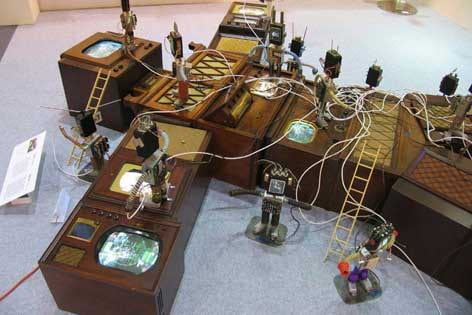Exhibition looks at TV with a new eye
The ubiquitous TV becomes sculpture in an exhibit of work by the late mixed-media artist Nam June Paik at Beall Center.

This is another in an occasional series called “UC I Can Afford It,” which highlights learning and recreational opportunities that are easy on the wallet and open to the campus community and beyond.
“Gulliver” lies on the floor, Lilliputians scurrying to restrain him, but these characters bear little resemblance to those in Jonathan Swift’s 1726 classic. “Gulliver” is sculpted of vintage TV cabinets, and his miniature captors have 5-inch LCD TV heads.
It’s all part of an exhibition of works by pioneering video artist Nam June Paik (1932-2006), which kicks off the new season at the Beall Center for Art & Technology on UC Irvine’s Claire Trevor School of the Arts campus. “Media Alchemy,” which runs through Dec. 5, features pieces from later in Paik’s life, including the rarely seen “Gulliver” (2001).
The world-renowned, Korean-born artist was among the first to use video for creative expression and strongly influenced future new-media installations. In the early ’60s, he exhibited TV sets as sculptural forms, with a custom-made synthesizer producing the images seen on the screens.
Often experimenting with the interplay of medium and message, Paik wanted viewers to never forget “the box.” Many of his works – “Gulliver” among them – incorporate old TV cabinets and Sony Watchman pocket TVs.
“Paik’s use of vintage TV cabinets makes a very important conceptual statement about television’s roots in radio,” says David Familian, exhibition curator and Beall Center associate director. “He underscores [media theorist] Marshall McLuhan’s perception that one medium progresses into another.”
“Media Alchemy” showcases Paik’s body/robot pieces, widely regarded as his most compelling. Typically larger than life-size and exaggerated, some depict actual people, while others are more literary (“Gulliver”) or methodical (“Internet Dweller”).
The exhibition includes:
- “Gulliver” (2001): A giant figure made of 11 vintage TV cabinets, one antique radio cabinet, 10 13-inch color TVs, one 19-inch color TV, a three-channel original Paik video (with four DVD players), and 18 mixed-media Lilliputians with 5-inch LCD TV heads.
- “Internet Dweller” (1994): No. 5 in a series of 12. A huge head made of two 10-inch Panasonic TVs, six 5-inch TVs, three vintage TV cabinets, a 19th century projector, a lantern, glass insulators, neon, one laserdisc player and one original Paik laserdisc.
- “Neon TV” (1990): From the “End of Communism” series. A vintage TV cabinet with neon tubing, three Sony Watchman TVs, antenna and Korean characters on glass.
The Beall Center for Art & Technology presents innovative exhibitions combining digital, audio and visual technology. Located at 712 Arts Plaza on campus, the gallery is open noon to 5 p.m. Tuesday and Wednesday, and noon to 8 p.m. Thursday through Saturday. Admission is free and open to the public. For more information, call 949-824-4339 or visit the Beall Center Web site.